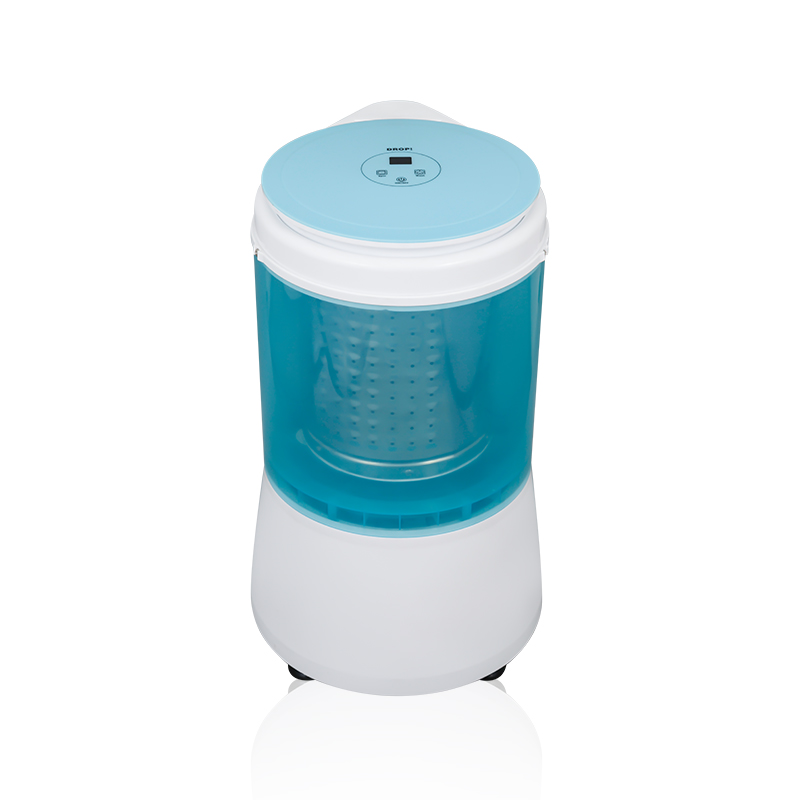No.62, Beiyihuan Road, Industry Area Zhangqi Town Cixi Ningbo China.
Phone:+86-13777243189
With the advancement of technology, many household appliances have been updated and upgraded, and the combination of washing machines and dryers has become an essential part of many homes. Among these appliances, Spin Dryers have gradually emerged, offering distinct advantages compared to traditional dryers.

A spin dryer is a device that removes moisture from clothes using the principle of centrifugal force. The core function of the spin dryer is to remove water from clothes through high-speed spinning, typically without involving any heating process.
The working principle of the spin dryer is relatively simple: inside the spin dryer, there is a rotating drum that, when driven by a motor, spins at high speed. As the drum spins, clothes are subjected to centrifugal force, causing the moisture to be pressed out, and the water is drained out through the machine’s drainage system. The spinning speed of a spin dryer typically ranges from 1,200 to 3,000 RPM, with higher speeds resulting in more efficient water removal.
Unlike traditional dryers, a spin dryer does not rely on hot air to dry clothes. It only removes moisture through centrifugal force, applying a physical principle to speed up the moisture removal process. This feature makes the spin dryer particularly suitable for clothes that need gentle treatment.
Spin dryers are generally equipped with an efficient drainage system that expels the moisture extracted from clothes. This process is very quick, and the clothes do not come into contact with any hot air, reducing the impact of humidity on the garments.
Traditional dryers and spin dryers differ significantly in their working principles, energy efficiency, and impact on clothes. Below, we compare these two types of devices in several key aspects.
Energy Efficiency of Spin Dryers
Spin dryers have a significant advantage in energy efficiency due to their unique working principle. They do not require heating air or electric heating elements; instead, they rely on the motor’s rotational power to expel moisture. Therefore, spin dryers consume much less energy in operation, making them a more energy-efficient choice, particularly for households that prioritize energy conservation.
Energy Consumption of Traditional Dryers
In contrast, traditional dryers rely on heating elements to heat the air, and hot air is then used to evaporate the moisture from clothes. The heating process requires a substantial amount of electricity, especially when the clothes are damp or when the ambient humidity is high. As a result, traditional dryers consume significantly more energy compared to spin dryers.
| Device Type | Working Principle | Energy Efficiency | Energy Consumption |
|---|---|---|---|
| Spin Dryer | High-speed spinning to expel moisture | Highly efficient | Low |
| Traditional Dryer | Uses hot air to evaporate moisture | Less efficient | High |
Working Speed of Spin Dryers
The working speed of a spin dryer is very fast, typically completing the moisture extraction process in 5 to 10 minutes. This speed is ideal for households that need to quickly remove moisture from clothes, especially in busy schedules where reducing drying time is a priority.
Working Speed of Traditional Dryers
In comparison, traditional dryers take much longer to complete the drying process. A full drying cycle may take 30 minutes to 1 hour, and the drying time increases when the clothes are heavily damp or thicker fabrics are involved.
Impact of Spin Dryer on Clothes
Because spin dryers do not involve hot air heating, they cause much less damage to clothes compared to traditional dryers. Spin dryers only expel moisture through centrifugal force, avoiding high temperatures, which reduces the risks of shrinking and fading. For delicate fabrics, spin dryers are a gentler option.
Impact of Traditional Dryers on Clothes
Traditional dryers, on the other hand, expose clothes to hot air, which can cause natural fibers (like cotton and wool) to shrink or fade due to prolonged high temperatures. Additionally, the mechanical friction caused by the hot air can reduce the durability of fabrics, especially with frequent use.
Maintenance and Usage Costs of Spin Dryers
Spin dryers have relatively simple structures and generally require minimal maintenance. Since they do not rely on heating elements, there are fewer components prone to wear or failure. Regular maintenance usually involves cleaning the drainage pipes and the drum. Over the long term, spin dryers tend to be more cost-effective because they do not consume a large amount of electricity.
Maintenance and Usage Costs of Traditional Dryers
Traditional dryers require more frequent maintenance, such as cleaning heating elements, air filters, and ensuring the internal mechanisms are functioning properly. Additionally, the heating elements in traditional dryers can wear out over time, leading to higher repair costs. More importantly, the high energy consumption of traditional dryers results in higher electricity bills over time.
Applicability of Spin Dryers
Spin dryers are primarily suitable for situations where you need to quickly remove moisture from clothes, such as in hot weather or when you want to avoid exposing clothes to high temperatures. If clothes do not need to be completely dry but simply need most of the moisture removed, a spin dryer is an excellent choice.
Applicability of Traditional Dryers
Traditional dryers are better suited for situations where clothes need to be thoroughly dried. Whether it’s cold winter weather or a humid environment where clothes won’t dry naturally, traditional dryers provide complete drying. They are ideal for items like towels, bed sheets, or heavy outerwear that require complete drying.